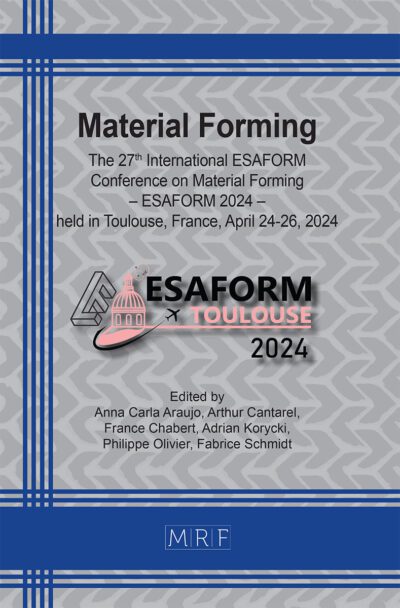Comprehensive analysis of waving defects in aluminium profile extrusion
Ivan Kniazkin, Ivan Kulakov, Nikolay Biba
Abstract. Waving defects in extruded aluminium profiles pose significant challenges to achieving the stringent geometrical tolerances required in industries such as automotive manufacturing. These defects, driven by flow velocity and thermal gradient imbalances, often emerge during later stages of the extrusion process, complicating early detection and mitigation efforts. This study investigates the mechanisms underlying waving defects through comprehensive simulations of industrial and benchmark profiles using QForm UK software. Critical insights into defect formation were achieved by analysing flow velocity and thermal variations across the extrusion process. The results highlight the interplay between feeder plate design, central feeding mechanisms, and billet discard length in influencing velocity deviations and subsequent wave formation. Moreover, the study demonstrates the importance of full-billet simulations in predicting these defects, as simplified approaches often fail to identify critical hidden variables. Practical recommendations are proposed to minimise waving defects and ensure high-quality, defect-free extrusions. These findings offer valuable strategies for advancing extrusion process design and meeting the rigorous demands of modern industries.
Keywords
Waving, Extrusion, Simulation, QForm, Defect, Aluminium, ALE Approach, Quality, FEA
Published online 5/7/2025, 10 pages
Copyright © 2025 by the author(s)
Published under license by Materials Research Forum LLC., Millersville PA, USA
Citation: Ivan Kniazkin, Ivan Kulakov, Nikolay Biba, Comprehensive analysis of waving defects in aluminium profile extrusion, Materials Research Proceedings, Vol. 54, pp 725-734, 2025
DOI: https://doi.org/10.21741/9781644903599-78
The article was published as article 78 of the book Material Forming
![]() Content from this work may be used under the terms of the Creative Commons Attribution 3.0 license. Any further distribution of this work must maintain attribution to the author(s) and the title of the work, journal citation and DOI.
Content from this work may be used under the terms of the Creative Commons Attribution 3.0 license. Any further distribution of this work must maintain attribution to the author(s) and the title of the work, journal citation and DOI.
References
[1] Z. Liu, L. Li, G. Wang, J. Yi, Analysis and improvement of material flow during extrusion process using spreading pocket die for large-size, flat-wide, and multi-ribs profile, The International Journal of Advanced Manufacturing Technology, 107 (2020) 1115–1129. https://doi.org/10.1007/s00170-020-04971-1
[2] C. Zhang, S. Yang, Q. Zhang, G. Zhao, P. Lu, W. Sun, Automatic optimization design of a feeder extrusion die with response surface methodology and mesh deformation technique. The International Journal of Advanced Manufacturing Technology 91 (2017) 3181–3193. https://doi.org/10.1007/s00170-017-0018-6
[3] Y.I Jie., Z.H. Wang, Z.W. Liu, J.M. Zhang, H.E. Xin, FE analysis of extrusion defect and optimization of metal flow in porthole die for complex hollow aluminium profile, Transactions of Nonferrous Metals Society of China, 28.10 (2018) 2094-2101. https://doi.org/10.1016/S1003-6326(18)64853-8
[4] F. Halvorsen, T. Aukrust, Studies of the mechanisms for buckling and waving in aluminum extrusion by use of a Lagrangian FEM software, International journal of plasticity, 22.1 (2006) 158-173. https://doi.org/10.1016/j.ijplas.2005.03.009
[5] I. Kniazkin, N. Biba, I. Kulakov, A. Duzhev, S. Stebunov, Automated Optimum Extrusion Die Design and Profile Quality Control Based on Simulation, Key Engineering Materials, 987 (2024) 31-40. https://doi.org/10.4028/p-8ZRuLD
[6] M. Negozio, R. Pelaccia, L. Donati, B. Reggiani, FEM Analysis of the Skin Contamination Behavior in the Extrusion of a AA6082 Profile, Key Engineering Materials, 926 (2022) 452-459.
https://doi.org/10.4028/p-y37nm3
[7] I. Kniazkin, R. Pelaccia, S. Di Donato, L. Donati, B. Reggiani, N. Biba, R. Rezvykh, I. Kulakov,
Investigation of the skin contamination predictability by means of QForm UK extrusion code, Materials Research Proceedings, 28 (2023) 543-552. https://doi.org/10.21741/9781644902479-59
[8] I. Kniazkin, A. Vlasov. Quality prediction of longitudinal seam welds in aluminium profile extrusion based on simulation, Procedia Manufacturing, 50 (2020) 433-438. https://doi.org/10.1016/j.promfg.2020.08.079
[9] J. Yu, G. Zhao, W. Cui, L. Chen, X. Chen, Evaluating the welding quality of longitudinal welds in a hollow profile manufactured by porthole die extrusion: Experiments and simulation, Journal of Manufacturing Processes, 38 (2019) 502-515. https://doi.org/10.1016/j.jmapro.2019.01.044
[10] I. Kniazkin. Prediction of Underfilling Defect in Aluminium Profile Extrusion Based on ALE
Simulation. Key Engineering Materials, 926 (2022) 537-544. https://doi.org/10.4028/p-42gaq6
[11] M. Negozio, A. Segatori, R. Pelaccia, B. Reggiani, L. Donati, Experimental investigation and numerical prediction of the peripheral coarse grain (PCG) evolution during the extrusion of different AA6082 aluminum alloy profiles, Materials Characterization, (2024) 113723. https://doi.org/10.1016/j.matchar.2024.113723
[12] M. Negozio, R. Pelaccia, L. Donati, B. Reggiani, Numerical investigation of the surface recrystallization during the extrusion of a AA6082 aluminum alloy under different process conditions, The International Journal of Advanced Manufacturing Technology, 129 (2023) 1585-1599. https://doi.org/10.1007/s00170-023-12397-8
[13] M. Negozio, R. Pelaccia, L. Donati, B. Reggiani, Simulation of the microstructure evolution during the extrusion of two industrial- scale AA6063 profiles, Journal of Manufacturing Processes, 99 (2023) 501-512. https://doi.org/10.1016/j.jmapro.2023.05.075













